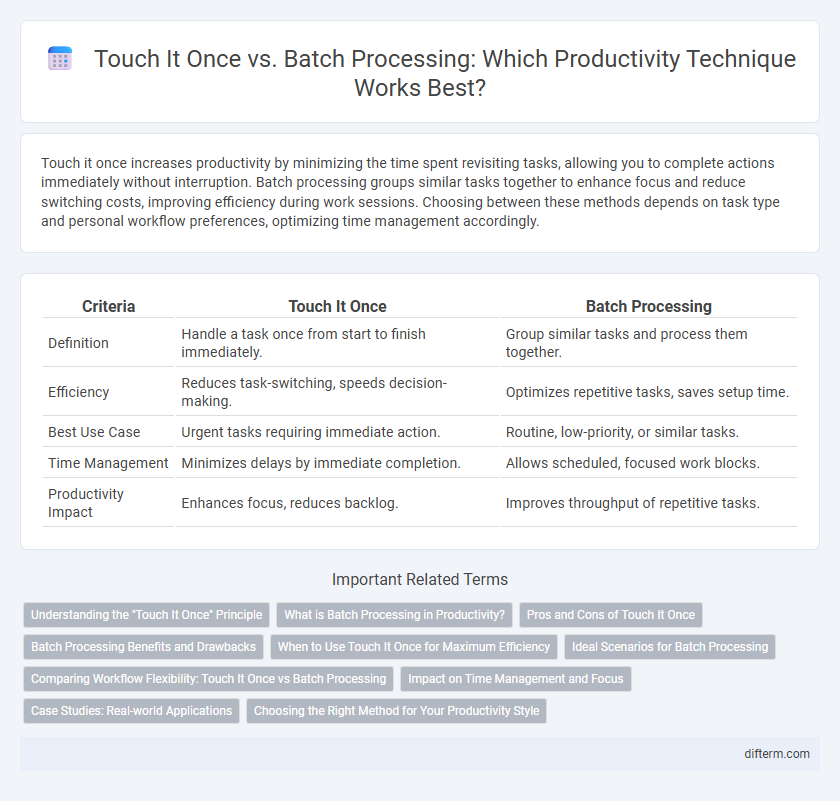Touch it once increases productivity by minimizing the time spent revisiting tasks, allowing you to complete actions immediately without interruption. Batch processing groups similar tasks together to enhance focus and reduce switching costs, improving efficiency during work sessions. Choosing between these methods depends on task type and personal workflow preferences, optimizing time management accordingly.
Table of Comparison
| Criteria | Touch It Once | Batch Processing |
|---|---|---|
| Definition | Handle a task once from start to finish immediately. | Group similar tasks and process them together. |
| Efficiency | Reduces task-switching, speeds decision-making. | Optimizes repetitive tasks, saves setup time. |
| Best Use Case | Urgent tasks requiring immediate action. | Routine, low-priority, or similar tasks. |
| Time Management | Minimizes delays by immediate completion. | Allows scheduled, focused work blocks. |
| Productivity Impact | Enhances focus, reduces backlog. | Improves throughput of repetitive tasks. |
Understanding the "Touch It Once" Principle
The "Touch It Once" principle emphasizes completing tasks immediately upon first interaction to minimize inefficiencies and cognitive load. This approach reduces the need for repeated handling, thereby enhancing focus and accelerating workflow. Adopting this method contrasts with batch processing, which groups similar tasks but can delay responses and increase mental clutter.
What is Batch Processing in Productivity?
Batch processing in productivity refers to grouping similar tasks together and completing them in a single uninterrupted session, minimizing context switching and enhancing focus. This method contrasts with the "Touch it once" approach, where each item is handled immediately upon receipt to prevent backlog accumulation. By allocating dedicated time blocks for similar activities, batch processing can significantly improve efficiency and reduce cognitive load.
Pros and Cons of Touch It Once
Touch it once boosts productivity by reducing task switching and minimizing time spent revisiting items, leading to greater focus and faster completion. It ensures immediate decision-making and action, which decreases backlog buildup and improves workflow efficiency. However, it may lead to rushed decisions and less opportunity for batching similar tasks that benefit from collective processing.
Batch Processing Benefits and Drawbacks
Batch processing enhances productivity by allowing multiple tasks to be completed simultaneously, reducing setup time and minimizing interruptions compared to Touch It Once methods. This approach is highly effective for repetitive, similar tasks like data entry or report generation but may introduce delays in real-time responsiveness due to task queuing. Despite increased efficiency in bulk handling, batch processing risks accumulating errors that can propagate through the entire batch, requiring thorough review and quality control mechanisms.
When to Use Touch It Once for Maximum Efficiency
Touch it once maximizes efficiency when tasks require immediate attention and minimal decision-making, such as responding to emails or filing documents. Batch processing is better suited for repetitive tasks that benefit from focused time blocks, like data entry or report generation. Use touch it once for quick decision tasks to reduce cognitive load and avoid workflow interruptions, increasing overall productivity.
Ideal Scenarios for Batch Processing
Batch processing excels in scenarios involving repetitive, high-volume tasks such as data entry, report generation, or invoice processing, where automation improves efficiency and reduces errors. Ideal settings include financial institutions managing end-of-day transactions, IT departments handling system backups, and manufacturing units processing bulk orders. Leveraging batch processing in these contexts streamlines workflows and maximizes resource utilization.
Comparing Workflow Flexibility: Touch It Once vs Batch Processing
Touch It Once enhances workflow flexibility by enabling immediate task completion and reducing time spent revisiting items, which minimizes context switching and improves focus. Batch processing, while efficient for handling similar tasks collectively, limits adaptability to urgent changes and interrupts continuous task flow. Businesses seeking agile productivity favor Touch It Once for its real-time responsiveness, whereas batch processing suits environments prioritizing standardized, repetitive task management.
Impact on Time Management and Focus
Touch it once enhances time management by minimizing task switching, allowing individuals to complete tasks fully before moving on, which sustains focus and reduces cognitive load. Batch processing groups similar tasks to streamline workflow, but can lead to prolonged periods of distraction and decreased mental clarity due to task accumulation. Both approaches impact productivity differently; touch it once improves immediate efficiency, while batch processing benefits repetitive task handling but may compromise sustained focus.
Case Studies: Real-world Applications
Case studies reveal that the "Touch It Once" approach enhances productivity by minimizing task switching and reducing cognitive load, as evidenced by efficiency gains in customer support centers where agents resolve inquiries in a single interaction. Conversely, batch processing proves effective in manufacturing and data analysis environments where grouping similar tasks reduces setup time and optimizes resource use. Real-world applications demonstrate that combining both methods tailored to specific workflows maximizes overall operational performance and time management.
Choosing the Right Method for Your Productivity Style
Selecting between Touch It Once and Batch Processing methods depends on individual work habits and task types. Touch It Once maximizes efficiency for quick decisions and small tasks by minimizing task switching, while Batch Processing groups similar tasks to reduce setup time and enhance focus on repetitive activities. Understanding personal productivity rhythms and task nature helps optimize workflow and boost overall efficiency.
Touch it once vs Batch processing Infographic

 difterm.com
difterm.com